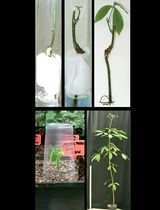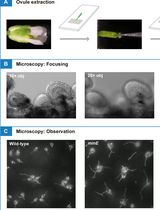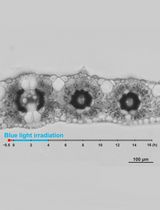- EN - English
- CN - 中文
Live Imaging of the Shoot Apical Meristem of Intact, Soil-Grown, Flowering Arabidopsis Plants
完整土培开花拟南芥植物茎尖分生组织的实时成像
发布: 2024年06月20日第14卷第12期 DOI: 10.21769/BioProtoc.5015 浏览次数: 2191
评审: Sarah C. PlechaJohn P PhelanAnonymous reviewer(s)
Abstract
All aerial organs in plants originate from the shoot apical meristem, a specialized tissue at the tip of a plant, enclosing a few stem cells. Understanding developmental dynamics within this tissue in relation to internal and external stimuli is of crucial importance. Imaging the meristem at the cellular level beyond very early stages requires the apex to be detached from the plant body, a procedure that does not allow studies in living, intact plants over longer periods. This protocol describes a new confocal microscopy method with the potential to image the shoot apical meristem of an intact, soil-grown, flowering Arabidopsis plant over several days. The setup opens new avenues to study apical stem cells, their interconnection with the whole plant, and their responses to environmental stimuli.
Key features
• Novel dissection and imaging method of the shoot apical meristem of Arabidopsis.
• Procedure performed with intact, soil-grown, flowering plants.
• Possibility of long-term live imaging of the shoot apical meristem.
• Protocol can be adapted to different plant species.
Keywords: Shoot apical meristem (茎尖分生组织)Background
In plants, above-ground organs are continuously generated from stem cells in the shoot apical meristem (SAM). This process is best described in the dicot plant Arabidopsis thaliana (reviewed in Fuchs and Lohmann [1]; Holt et al. [2]; Hong and Fletcher [3]; Janocha and Lohmann [4]). The initial vegetative SAM produces only leaves but changes into a reproductive SAM after transition to flowering. A subset of cells within the SAM will eventually lead to the formation of gametes. Mature flowers and siliques are formed after bolting when the main stem emerges from the basal rosette and the SAM changes into an inflorescence meristem (IM). Following the fate of stem cells during these important transitions of the meristem is therefore of utmost importance to understand this developmental program.
Different approaches have delivered detailed information about meristem development [5–7]. However, most techniques require dissection, staining, or cell separation and are not compatible with the observation of dynamic processes. Live imaging of the SAM has overcome this limitation to some extent but is usually performed by detaching the shoot tip of a bolting plant, placing it in a microscopy-suited vessel filled with growth medium and submerging it in water, followed by removing flowers and buds before microscopy observation [8–11].
In an alternative setup, Grandjean et al. [12] recorded SAM development in intact plants using an inverted microscope, with the drawback of working against gravity. This was later overcome by Heisler et al. [13] and Tobin and Meyerowitz [14]. These authors proposed observing the SAM under physiological conditions, after removing surrounding flower buds from a plant prior to bolting without separating it from the plant body, keeping it completely underwater. However, this limited the observations to an early stage, and the complete submergence of the plant can cause hypoxia and corresponding side effects on the development [15]. These side effects could be reduced by placing only a water drop between the plant tip and the front lens of a water immersion objective [14], however, at the price of low stability and restricted time for the acquisition.
The protocol described here provides an innovative method to observe the SAM of bolting Arabidopsis plants without detaching it from the stem. An “easy-to-built” custom-made device allows the preparation of the main inflorescence of a soil-grown plant for subsequent observation with an upright confocal microscope. This system limits submergence to the very top and permits precise positioning of the exposed SAM in all dimensions. In addition, the observation of the living SAM can be extended over several days, while the plant grows in regular substrate, light, and oxygen supply. The setup allows further control and variation of environmental conditions like drought, salinity, light stress, hormone or drug application, and pathogen infections. The procedure can likely be modified to also study meristem development in species with similar size and growth architecture as Arabidopsis.
Materials and reagents
Biological material
Plants (Arabidopsis thaliana) in a suitable stage of inflorescence meristem development, e.g., three weeks grown at 8:16 h light/dark cycles followed by two weeks at 16:8 h light/dark cycles (short- and long-day regimes, respectively) at 21 °C with 60% relative humidity and 150 µmol m-2·s-1 light intensity), grown in soil in round 5 cm diameter pots
For proof of concept used in this protocol: a transgenic Arabidopsis plant carrying a stem cell–specific nuclear marker (ProCLV3:H2B-mCherry, Gutzat et al. [16]) in addition to the ubiquitously expressed nuclear marker ProHTR5:H2A-mNeonGreen (unpublished construct, assembled with modules described in Donà et al. [17])
Reagents
Low melting agarose (LMA) (Roth, catalog number: 6351)
Distilled water
Solutions
1.5% LMA in water. Aliquots can be stored in Eppendorf tubes at 4 °C
Laboratory Supplies
Sterilin Petri dishes 50 mm (Thermo Fisher Scientific, catalog number: 124-17)
FEP tubing (inner diameter 2.8 mm, outer diameter 3.2 mm, Wolf-Technik)
Sample tubes 0.6 mL, microcentrifuge tubes low retention (Thermo Fisher Scientific, catalog number: 3446) for LMA aliquots
Glass capillary Transferpettor, caps cert. 100 µL (Brand, catalog number: 701910)
Piston rod Transferpettor (Brand, catalog number: 701938)
Patafix glue pads (Uhu, catalog number: 64797)
Round plant pots with 5 cm diameter (e.g., singularized from trays, HerkuPlast HP D 60/5.5 R)
Standard soil (e.g., Profi Substrat, Gramoflor)
Equipment
Dissection desk (table with opening on the top, with appropriate height range for the lifting station (width 58 cm, depth 40 cm, height 38 cm; hole diameter 11 cm)
Stereomicroscope with opening on the stage (Leica MZ6)
Lifting station (e.g., Swiss Boy Lab jack)
Petri dish prepared with a central opening into which a 1.5 cm plastic tube is fixed (prepared in a workshop by drilling a central opening and gluing the plastic tube, e.g., with AL-FIX Füllstoff Noviqua glue)
Adjustable stem holder fitting the opening of the stereomicroscope stage and the modified Petri dish with a central tube [prepared in a workshop from laminated wood (light blue), plastic material (black disc), metal parts, and a screw for movement]
Thermoblock (Eppendorf Themomixer comfort) matching LMA sample tubes
Fine forceps (Ideal-tek 3C.SA or Dumont No. 5)
Needles (Sterican Gr.1: 0.90 mm × 40 mm, yellow)
Syringes (Tuberculin Luer. Chirana 1 mL CHTUB01) with attached plastic tube or pipette
Upright confocal microscope without condenser (Zeiss LSM700 Axio Imager 2)
Water dipping lenses (Zeiss W N-Achroplan 40×/0.75)
Plexiglass microscope stage insert with central opening (prepared in a workshop by drilling a central opening; width 15 cm, depth, 15 cm, height 0.5 cm; hole diameter 3 cm)
LED light illumination (Model TXD-6, GRENEBO)
Plant growth chamber (e.g., Photon System Instruments)
Software and datasets
Microscope software: ZEN 2010 Version 6.0
Visualization software: Imaris 10
Procedure
文章信息
版权信息
© 2024 The Author(s); This is an open access article under the CC BY-NC license (https://creativecommons.org/licenses/by-nc/4.0/).
如何引用
Bradamante, G. (2024). Live Imaging of the Shoot Apical Meristem of Intact, Soil-Grown, Flowering Arabidopsis Plants. Bio-protocol 14(12): e5015. DOI: 10.21769/BioProtoc.5015.
分类
植物科学 > 植物发育生物学 > 综合
细胞生物学 > 细胞成像 > 活细胞成像
您对这篇实验方法有问题吗?
在此处发布您的问题,我们将邀请本文作者来回答。同时,我们会将您的问题发布到Bio-protocol Exchange,以便寻求社区成员的帮助。
Share
Bluesky
X
Copy link












